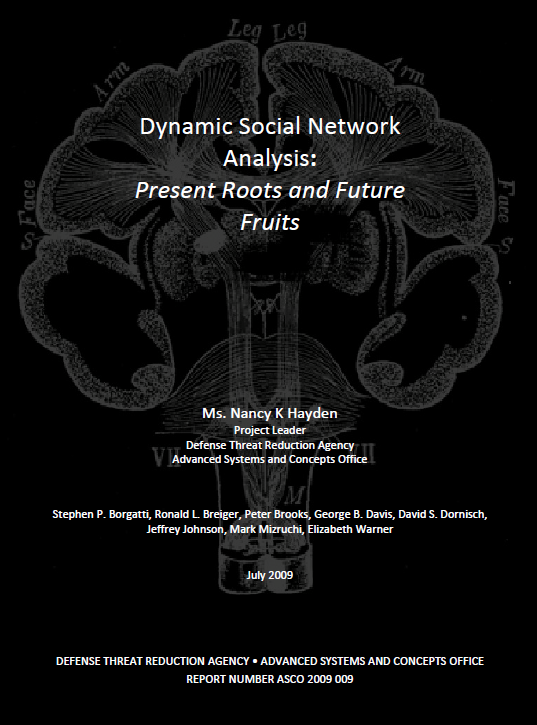Dynamic Social Network Analysis: Present Roots and Future Fruits
- 170 pages
- July 2009
- 8.71 MB
In today’s threat environment, social networks have come to be thought of as broad organizing concepts for national security policy-making. The Advanced Systems and Concepts Office of the Defense Threat Reduction Agency (DTRA/ASCO) is examining implications of this conceptualization by evaluating:
• What types of questions can be addressed through the framework of social networks?
• How confident can one be in the conclusions based on social network analysis (SNA)?
• What kind of long term understanding does the social network paradigm promote, and what might it miss?
• What role does SNA have to play in DTRA’s mission for countering Weapons of Mass Destruction (WMD)?
• What are the best practices for applying SNA and where does the best expertise lie?
• What research may be needed to enhance the potential of SNA to further DTRA’s goals?To facilitate this evaluation, ASCO invited a small group of leading researchers in SNA to come together at the DTRA Headquarters with government program managers and analysts from the intelligence community to discuss—from both theoretical and applied research perspectives—the state of the art in SNA, experiences with its application within the US government, and research efforts currently underway and/or needed to advance the state of the art, and the promise and limits to its potential.
ASCO conducted this two day seminar on 14-15 February 2008 at the unclassified and classified levels. The program was organized around themes of (1) theoretical underpinnings of SNA, (2) state of the art in SNA applications, (3) collective wisdom on issues, research needs, and recommendations, and (4) SNA applications to national security. A key question asked of the participants in the unclassified session was, “What are the optimal investments in SNA (for further research as well as for applications) that can be made by DTRA and by other government agencies?” At the classified level, we reviewed the types of use cases being addressed by SNA methodology within the IC, insights provided, the technologies utilized, and unmet needs. In addressing these questions, participants were asked to think about the subject of tacit knowledge: not just where they recommended that SNA had been or could be useful, but also where they advised it should NOT be relied upon.
The workshop began with academic subject matter experts describing current theoretical understanding of SNA and its potential for application to problem spaces of interest to DTRA. Professor Steve Borgatti (University of Kentucky) led off with an overview of the SNA paradigm, its theoretical foundations, and current research efforts to develop an overarching theoretical framework that spans across social science disciplines. Professor Jeff Johnson (East Carolina University) followed with a presentation on data issues in applications and interpretations of SNA results. Carnegie Mellon University doctoral student George Davis, who is a research fellow under Dr. Kathleen Carley at the Center for Computational Analysis of Social and Organizational Systems (CASOS), described current advances in computational methodologies available to analysts for dynamic, path-dependent social network analysis. Professor Mark Mizruchi (University of Michigan) then spoke on the problems of determining causality and developing prescriptive actions based on SNA.
This academic interchange was followed by a panel of government personnel who shared their experiences with applications of SNA on national security problems that ranged from the tactical to the strategic. A round table discussion followed, in which all participants joined in exploration of how to build bridges that could be sustained between ongoing academic research efforts and the evolving needs of both government analysts and policy decision-makers for responsible and informed use of SNA in national security applications. Professor Breiger closed with a summary of the current status of SNA, challenges, and promises for the future, as seen from the perspective of academia shaped through the interactions with government users during the seminar.

